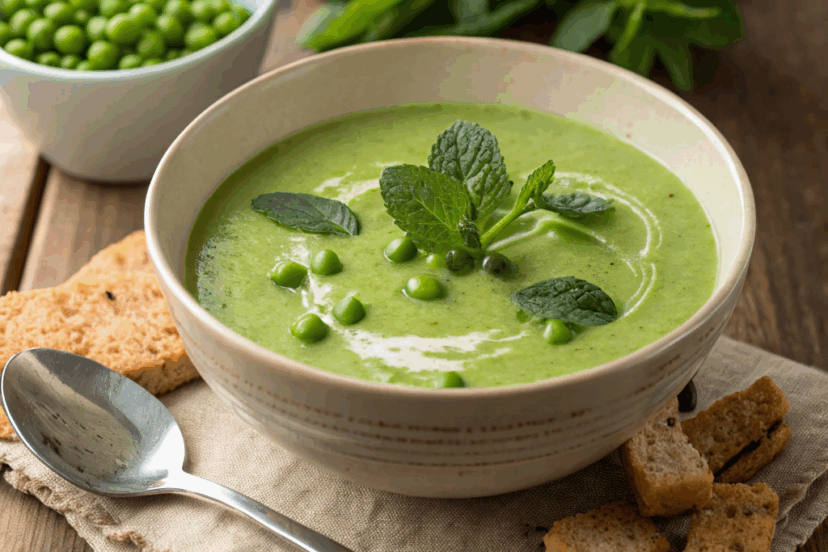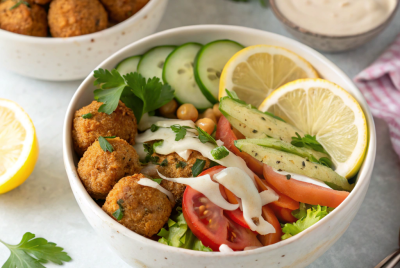Pea and Mint Soup – Easy & Creamy Spring Recipe
There’s something magical about the first spoonful of a perfectly made pea and mint soup. The vibrant green color, the sweet aroma of fresh peas mingling with aromatic fresh mint leaves – it’s springtime captured in a bowl. Over my years of cooking, I’ve perfected my own version of this classic mint soup, and today I’m thrilled to share my comprehensive guide to creating this delightful dish that has been warming hearts and homes for generations.
The Timeless Appeal of Pea and Mint Soup
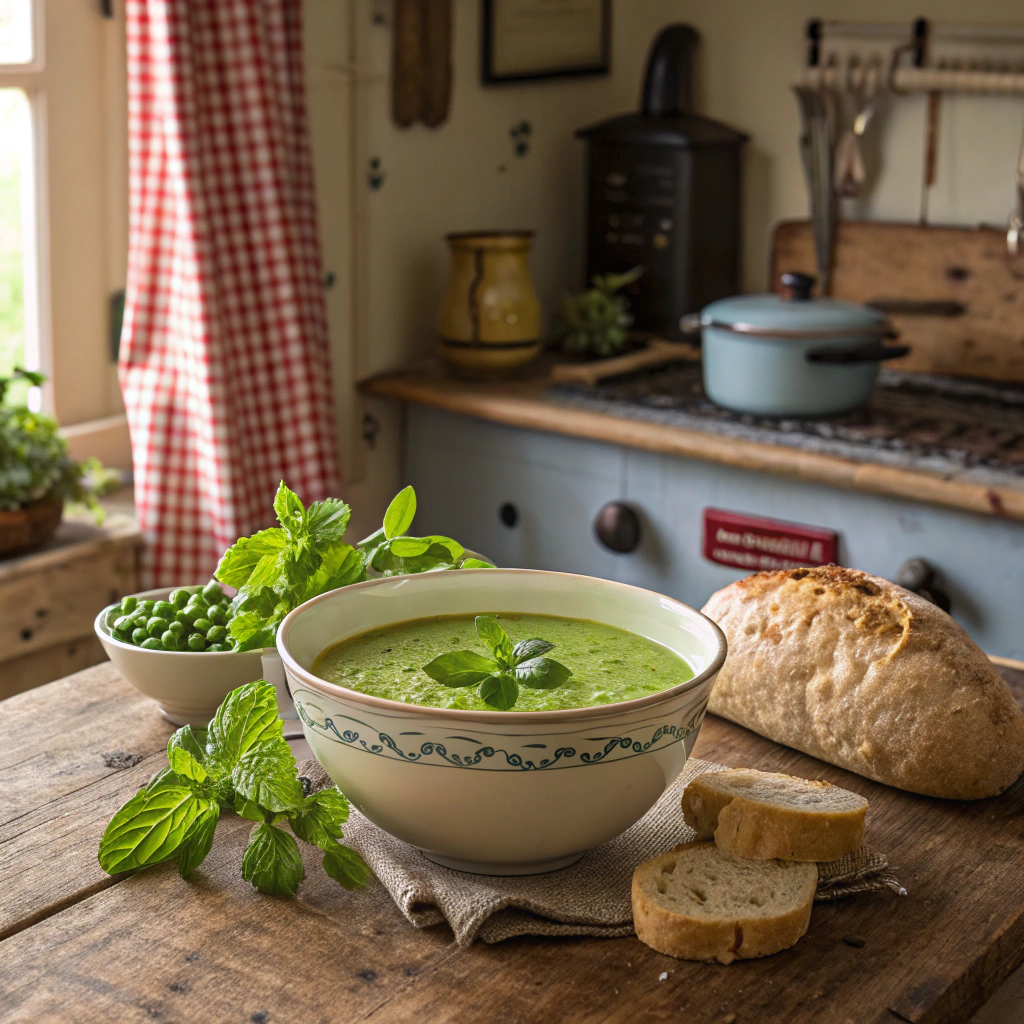
My love affair with pea and mint soup began during my first visit to the English countryside. There, in a quaint village pub, I tasted a bowl of this vibrant green elixir that forever changed my perception of simple soup recipes. The combination of sweet peas and mint creates one of those rare dishes that feels both nostalgic and fresh at the same time.
What makes this soup so special isn’t just its incredible flavor but also its versatility. Whether you’re looking for a quick weeknight dinner, an elegant starter for guests, or a comforting lunch, this pea soup recipe delivers every time. The beautiful green color makes it visually stunning, while the creamy texture satisfies on a deeply comforting level.
Origins and Traditions of Pea and Mint Soup
Pea soup itself has a rich history dating back centuries. Dried peas have been a staple food across Europe since ancient times, prized for their long shelf life and high nutritional value. The earliest documented pea soups were simple affairs – dried peas cooked with whatever herbs and vegetables were available.
The brilliant pairing of peas with mint, however, is distinctly British in origin. This combination emerged in English cooking during the 18th century when fresh garden peas became more widely cultivated. The addition of fresh mint leaves was originally a practical decision – mint grows abundantly in British gardens right alongside peas, and the herbs were found to complement each other perfectly.
The tradition of serving pea and mint soup grew particularly strong during the Victorian era, when it became a fashionable first course at dinner parties. Today, this tasty soup remains a beloved classic throughout Britain and has spread worldwide as people discover the magic of this simple but extraordinary pairing.
Health Benefits of Pea and Mint Soup
Before diving into the recipe, let’s talk about why this soup isn’t just delicious but also incredibly good for you. Green peas are nutritional powerhouses, often overlooked in discussions about superfoods.
Why Green Peas Are Nutrition Superstars
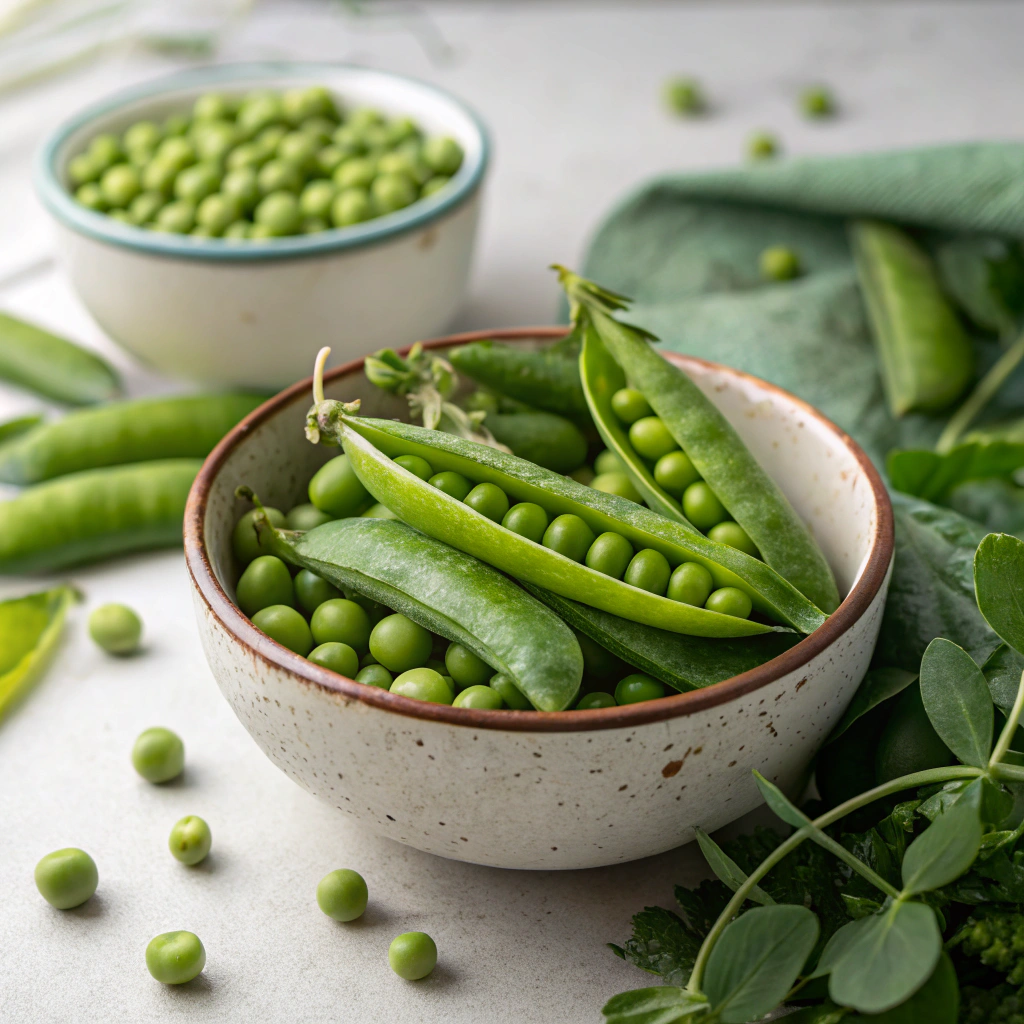
Fresh peas are packed with:
- Plant-based protein (approximately 8g per cup)
- Fiber (nearly 9g per cup)
- Vitamins A, C, K, and many B vitamins
- Minerals including manganese, iron, zinc, and magnesium
- Antioxidants that help reduce inflammation
The high fiber content of peas helps support digestive health, while their protein content makes this soup surprisingly filling. This combination of health benefits makes pea and mint soup an excellent choice for anyone looking to incorporate more nutrient-dense foods into their diet.
Mint’s Amazing Properties
The fresh mint leaves in this soup aren’t just for flavor. Mint has been used medicinally for thousands of years and offers impressive benefits:
- Aids digestion and may help relieve indigestion
- Contains antioxidants that help protect cells from damage
- Provides a natural cooling sensation that’s particularly refreshing
- Contains small amounts of vitamins A and C
Together, peas and mint create not just a delicious meal but a genuinely nutritious one that supports overall wellbeing.
My Perfect Pea and Mint Soup Recipe
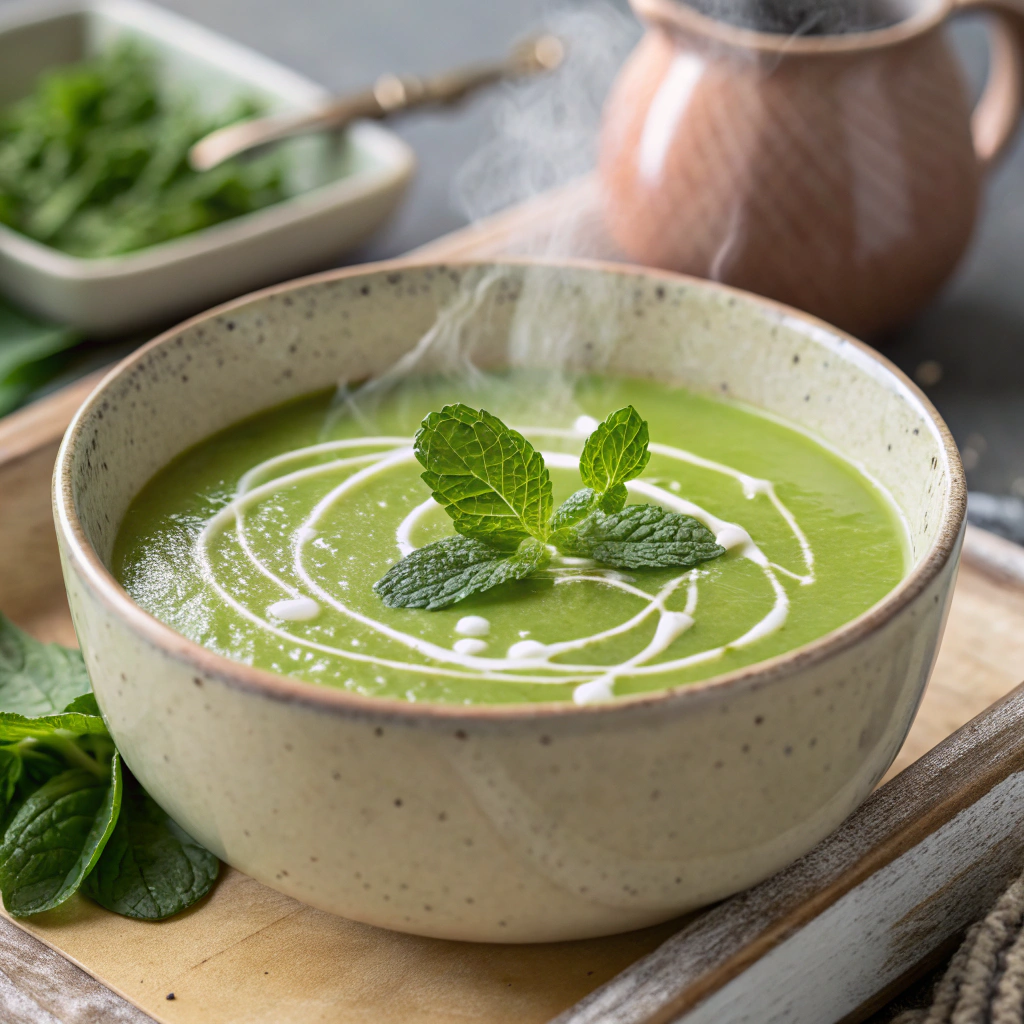
After many iterations, I’ve developed what I consider the ideal fresh pea soup recipe. It strikes the perfect balance between the sweetness of the peas and the brightness of the mint, with a creamy texture that’s luxurious without being heavy.
Ingredients You’ll Need
- 4 cups (600g) fresh peas (or frozen if fresh aren’t available)
- 1 cup (25g) fresh mint leaves, loosely packed, plus extra for garnish
- 1 medium yellow onion, chopped
- 2 cloves garlic, minced
- 2 tablespoons unsalted butter or olive oil (use olive oil for vegan version)
- 4 cups vegetable broth or vegetable stock
- 1/2 cup coconut milk or heavy cream
- 1 teaspoon salt (or teaspoon sea salt for a more mineral flavor)
- Freshly ground black pepper to taste
- 1 tablespoon lemon juice
- Optional garnishes: pea shoots, spring onions, creme fraiche, or a drizzle of extra virgin olive oil
Equipment List
- Large saucepan or large pan
- Immersion blender, hand blender, or food processor
- Wooden spoon
- Measuring cups and spoons
- Cutting board and knife
- Ladle
- Soup bowls for serving
Preparation Time
- Prep time: 15 minutes
- Cook time: 25 minutes
- Total time: 40 minutes
- Servings: 4-6
Step-by-Step Cooking Instructions for The Perfect Pea And Mint Soup
Step 1: Prepare Your Base
- In a large saucepan over medium heat, melt the unsalted butter or warm the olive oil.
- Add the chopped yellow onion and cook until translucent, about 5 minutes, stirring occasionally.
- Add the minced garlic and continue cooking for another minute until fragrant. Be careful not to let the garlic brown as this can make it bitter.
Step 2: Add Peas and Broth
- Add the fresh peas (or frozen) to the pan and stir to coat them with the onion mixture.
- Pour in the vegetable broth or vegetable stock and bring to a gentle simmer over medium-high heat.
- Once simmering, reduce to low heat and cook for about 5-7 minutes until the peas are tender but still bright green.
Step 3: Add The Mint
- Remove the pan from the heat and add the fresh mint leaves. The residual heat will wilt the mint and release its oils without destroying its bright flavor.
- Allow the mixture to cool slightly for about 5 minutes. This step is important as it preserves the vibrant color and prevents the mint from becoming bitter.
Step 4: Blend to Perfection
- Using an immersion blender or hand blender, carefully puree the soup directly in the pot until smooth. Alternatively, you can transfer batches to a food processor to achieve a silky purée soup.
- If you prefer a thinner soup, add a bit more vegetable broth at this stage.
Step 5: Finish and Season
- Return the soup to low heat and stir in the coconut milk or cream.
- Add teaspoon salt, black pepper, and a squeeze of lemon juice.
- Warm gently without boiling (boiling can dull the bright color and fresh flavors).
- Taste and adjust seasonings as needed. The combination of mint with the sweetness of peas should be balanced and bright.
Step 6: Serve and Garnish
- Ladle the warm soup into soup bowls.
- Garnish with any combination of: a few small fresh mint leaves, a swirl of creme fraiche or sour cream, a drizzle of extra virgin olive oil, pea shoots, or finely chopped spring onions.
- Serve immediately with crusty bread for a complete delicious meal.
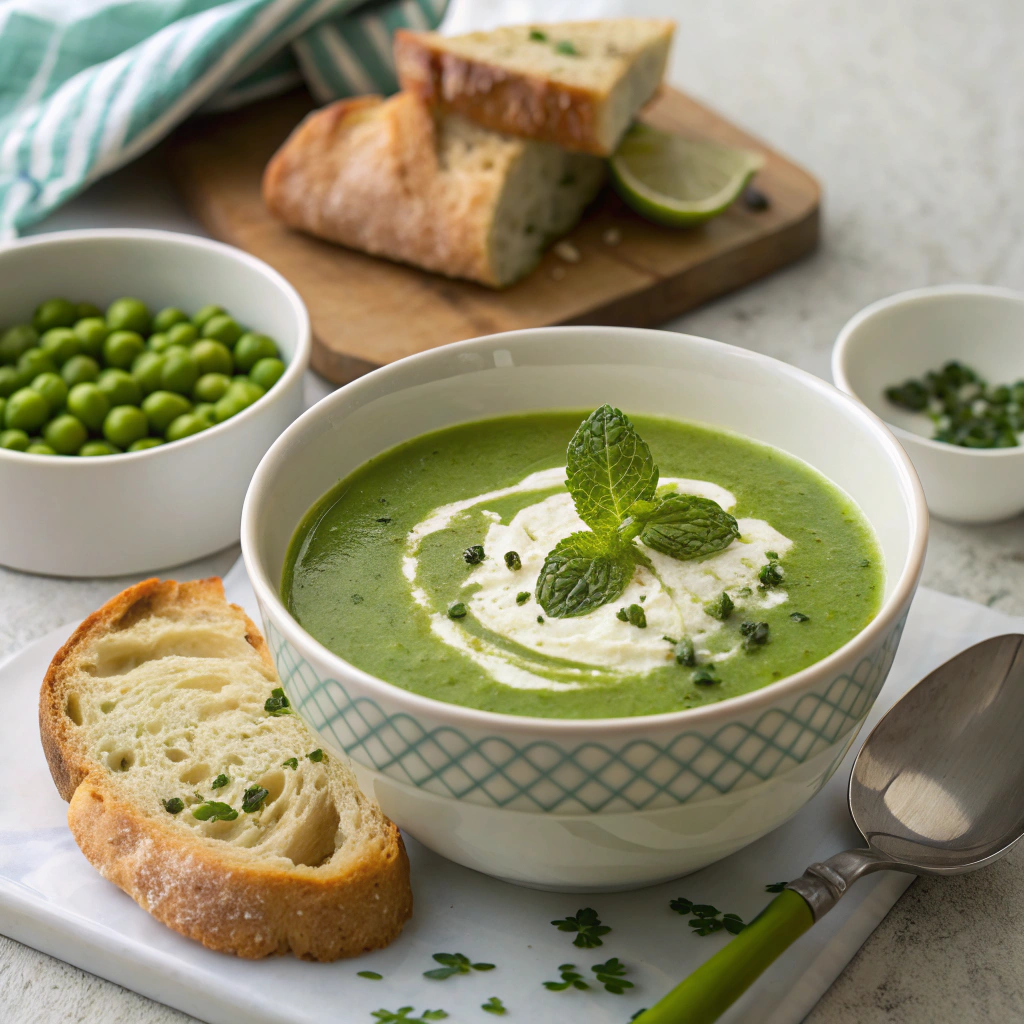
Storage and Reheating Tips for Your Pea And Mint Soup
This pea and mint soup keeps beautifully, and many people (myself included) think it tastes even better the next day when the flavors have had time to meld.
- Refrigeration: Store finished soup in an airtight container in the refrigerator for up to 3 days.
- Freezing: This soup freezes exceptionally well for up to 3 months. The bright green color may fade slightly upon thawing, but the flavor remains excellent.
- Reheating: Warm gently over low heat, stirring occasionally. Do not boil, as this can affect both texture and color.
Dietary Adaptations and Variations
Vegan Pea and Mint Soup
Making this soup vegan is incredibly simple:
- Replace unsalted butter with olive oil or plant-based butter
- Use coconut milk instead of dairy cream
- Ensure your vegetable stock is vegan (some commercial brands contain honey or other animal products)
- Skip the creme fraiche garnish or use a cashew-based vegan alternative
The resulting soup is just as creamy and delicious, with all the same vibrant flavors.
Gluten-Free Pea And Mint Soup
Good news! This pea and mint soup is naturally gluten-free, as long as you check that your vegetable broth doesn’t contain any gluten additives (most don’t, but it’s always good to verify, especially with bouillon cubes or powders).
Low-Calorie Pea And Mint Soup
For a lighter version:
- Use just 1 tablespoon of olive oil instead of 2 tablespoons of butter
- Replace the cream or coconut milk with unsweetened almond milk
- Garnish with herbs rather than creme fraiche or oil
Creative Variations on the Classic Pea And Mint Soup
While the traditional pea and mint soup is perfect as is, here are some exciting variations I’ve experimented with over the years:
Spiced Pea and Mint Soup
Add a teaspoon of ground cumin and half a teaspoon of coriander when sautéing the onions for a subtle warmth that complements the cool mint beautifully.
Pea, Mint and Watercress Soup
Add a bunch of watercress along with the mint for an even more vibrant green color and peppery flavor that works wonderfully with the sweet peas.
Pea, Mint and Potato Soup
Add a medium potato, peeled and diced, along with the peas for an even creamier, more substantial soup that makes a complete meal.
Serving Suggestions and Pairings for Pea And Mint Soup
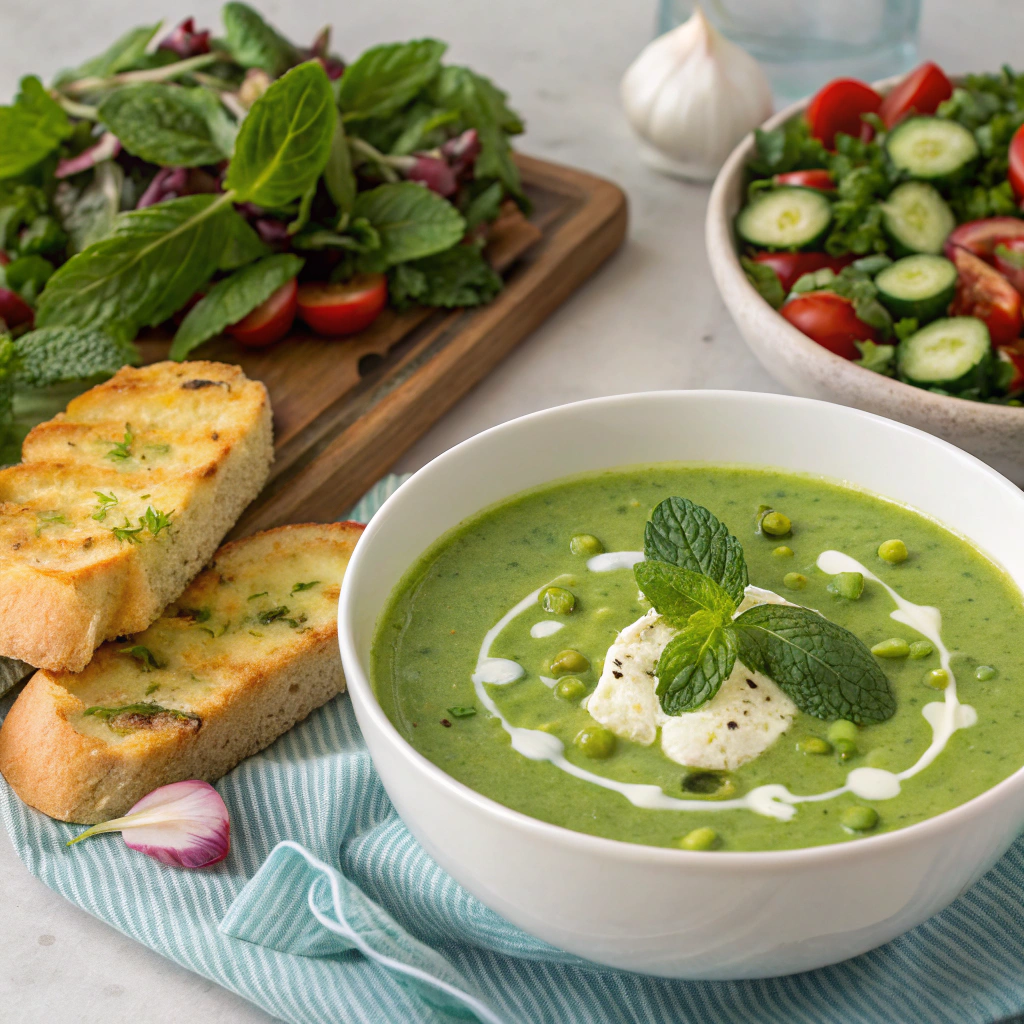
Perfect Accompaniments
This fresh pea soup pairs beautifully with:
- Crusty bread or garlic bread for dipping
- A simple green salad with a light vinaigrette
- Grilled cheese sandwiches for a more substantial meal
- Crostini topped with red onion and goat cheese
Seasonal Menu Ideas
In spring and summer, I love to serve this soup as part of a fresh seasonal menu:
- Starter: Pea and mint soup in small cups
- Main: Spring vegetable risotto or a light pasta primavera
- Dessert: Lemon tart or strawberry shortcake
In cooler months, this bright soup provides a lovely contrast to heartier fare:
- Starter: Pea and mint soup
- Main: Roasted chicken or fish with root vegetables
- Dessert: Apple crumble or pear tart
Add-Ons and Toppings to Elevate Your Pea And Mint Soup
The right garnishes can take this simple soup to new heights. Here are my favorite ways to dress up a bowl of pea and mint soup:
Crunchy Elements
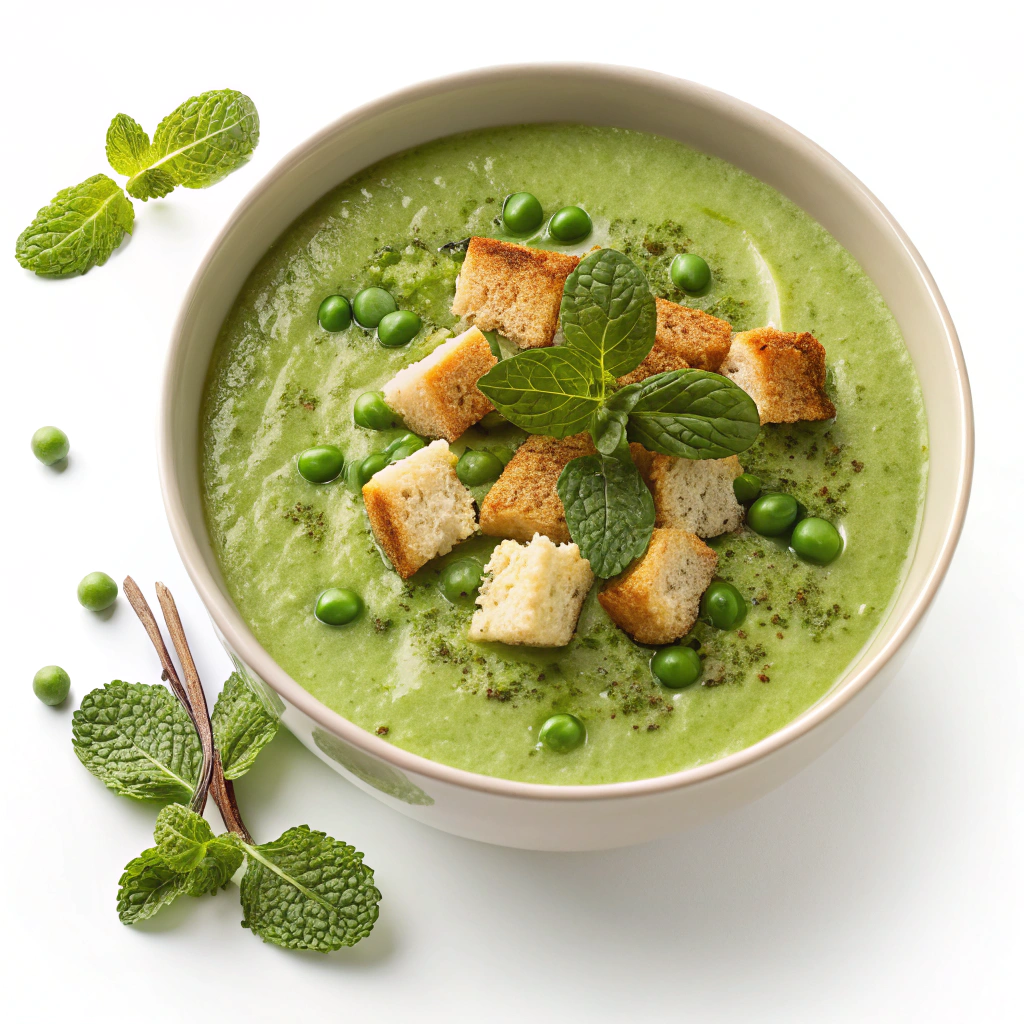
- Homemade croutons made from crusty bread
- Crispy bacon bits (omit for vegetarian/vegan versions)
- Toasted pine nuts or pumpkin seeds
- Crispy fried shallots
Creamy Additions
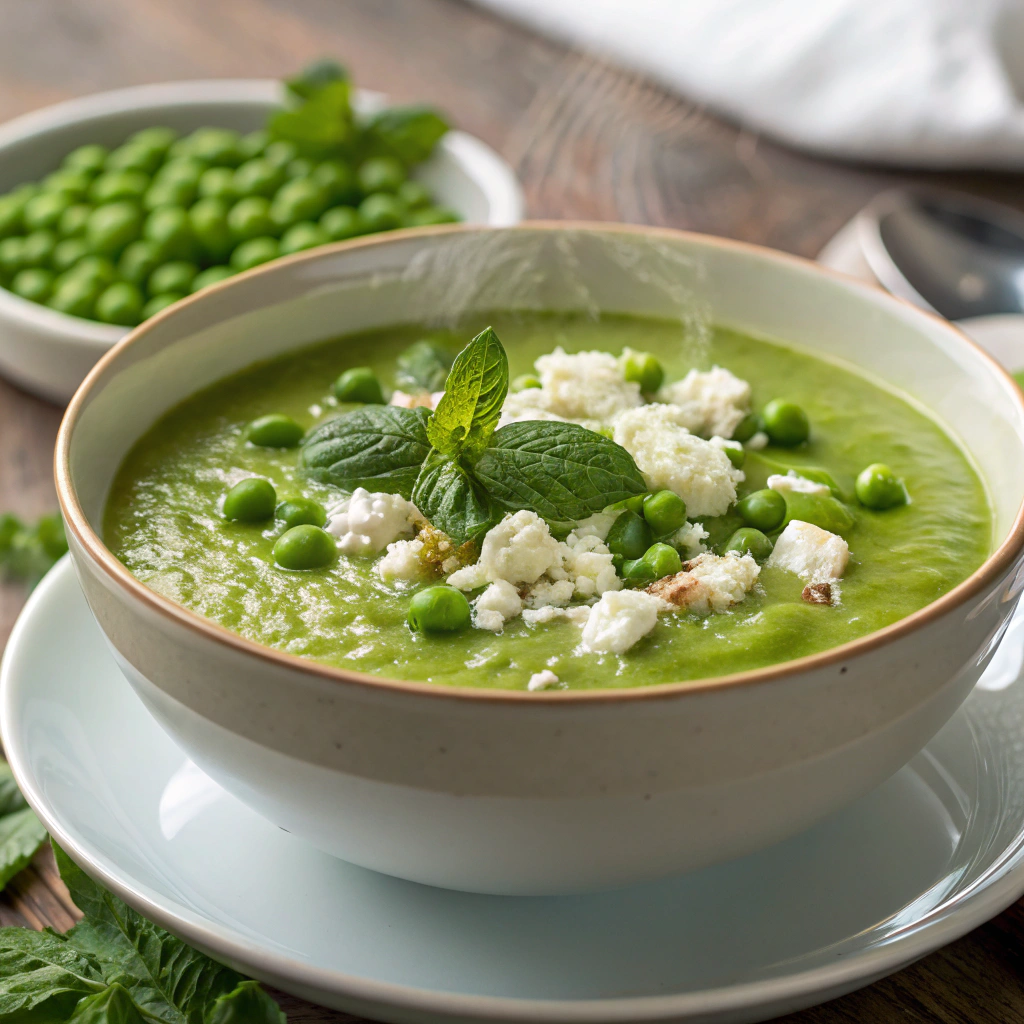
- A dollop of sour cream or creme fraiche
- Crumbled feta cheese
- A drizzle of coconut milk
- Soft goat cheese that melts slightly into the warm soup
Fresh Finishes
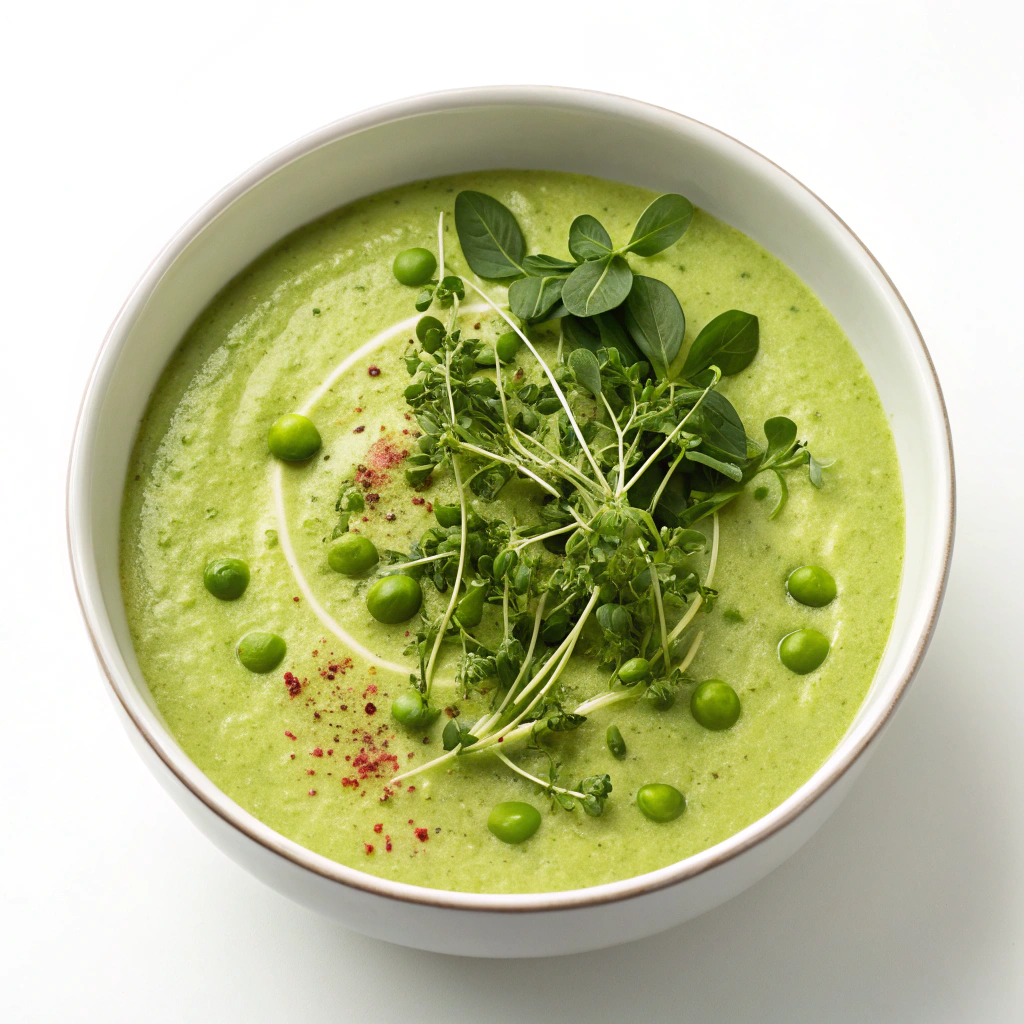
- Extra chopped fresh mint leaves
- Microgreens or pea shoots
- Finely diced spring onions
- A light drizzle of lemon juice just before serving
Pro Tips For Perfect Pea and Mint Soup
After years of making this soup, I’ve gathered some insights that make all the difference:
Choosing Your Peas
- Fresh peas straight from the pod make the most exceptional soup, but they’re seasonal and time-consuming to shell
- Frozen peas are an excellent alternative and often more convenient – they’re flash-frozen at peak freshness
- If using frozen peas, don’t thaw them first; add them directly to the pot
- Visit your local farmers’ market or grocery store during spring for the freshest delicate peas
Mastering the Mint
- Use fresh mint leaves only; dried mint won’t provide the same bright flavor
- Add mint off the heat to preserve its volatile oils and prevent bitterness
- Different mint varieties offer subtly different flavors – spearmint is traditional, but chocolate mint or pineapple mint can create interesting variations
- Save a few of the smallest, most tender mint leaves for garnish
Texture Techniques
For the perfect creamy texture:
- Don’t overcook the peas – they should remain bright green
- For an ultra-silky soup, pass it through a fine-mesh strainer after blending
- If you like some texture, reserve a few tablespoons of cooked peas before blending and add them back afterward
- The hand blender technique: blend in pulses rather than continuously for better control over the final texture
Nutritional Information for Pea And Mint Soup
This pea and mint soup isn’t just delicious—it’s nutritious too. Here’s the approximate nutritional content per serving (based on 6 servings):
| Nutrient | Amount |
| Calories | 185 |
| Protein | 8g |
| Carbohydrates | 20g |
| Fiber | 7g |
| Sugar | 8g |
| Fat | 9g |
| Saturated Fat | 5g |
| Sodium | 645mg |
| Vitamin A | 25% DV |
| Vitamin C | 40% DV |
| Iron | 15% DV |
| Calcium | 8% DV |
Note: Values will vary depending on specific ingredients and whether you use butter or oil, cream or coconut milk.
Seasonal Considerations
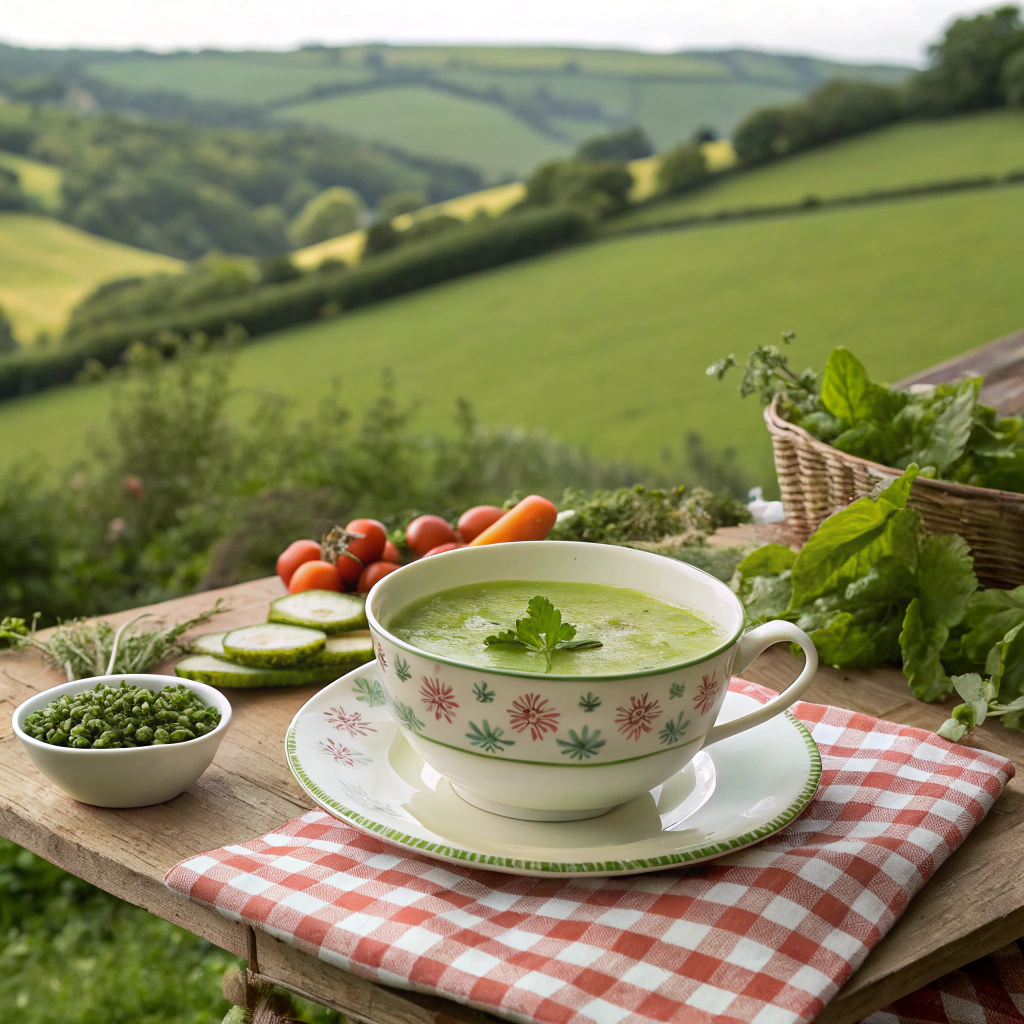
While pea and mint soup is classically associated with spring, this great recipe can be enjoyed year-round with some seasonal adjustments:
Spring
This is when pea and mint soup truly shines! Use the freshest garden peas and tender young mint that’s just beginning to flourish. A lighter version with a bit more lemon juice captures the essence of the season.
Summer
For hot days, consider serving this soup chilled (similar to a green gazpacho). Increase the mint slightly and add extra lemon juice for a refreshing summer dish.
Fall/Winter
In cooler months, use frozen peas and create a slightly heartier version by adding a potato or increasing the coconut milk. Garnish with crispy fried sage alongside the mint for a warming touch.
Why This Pea And Mint Soup Recipe Works: The Science Behind
Understanding a bit about the science behind cooking can help ensure your pea and mint soup turns out perfectly every time:
Why We Add Mint After Cooking
Heat breaks down the delicate aromatic compounds in mint. By adding it after removing the pot from heat, we preserve its volatile oils and bright flavor.
The Importance of Quick Cooking
Green peas contain chlorophyll, which gives them their vibrant color. Prolonged cooking breaks down chlorophyll, turning your bright green soup into a duller olive color. This is why we cook the peas just until tender, usually 5-7 minutes.
The Role of Acid
The lemon juice does more than add flavor – the acidity helps maintain the bright green color of the soup. However, adding it while cooking can affect the texture of the peas, which is why we add it at the end.
From Garden to Table: Growing Your Ingredients
If you have even a small garden space or a few containers, growing your own peas and mint can make this soup even more special:
Growing Peas
- Peas prefer cool weather and can be planted as soon as soil can be worked in spring
- They need little space if provided with vertical support
- Harvest when pods are plump but before they become starchy
- Succession planting every 2-3 weeks provides a longer harvest season
Growing Mint
- Mint is incredibly easy to grow – almost too easy! It’s best contained in pots to prevent it from taking over
- It thrives in partial shade and moist soil
- Regular harvesting encourages bushy growth
- Even a small pot on a windowsill can provide enough mint for several batches of soup
There’s something deeply satisfying about making pea and mint soup with ingredients you’ve grown yourself. The flavors are incomparable, and the connection to the food is meaningful.
Conclusion: Why Pea and Mint Soup Deserves a Place in Your Recipe Collection
After exploring every aspect of pea and mint soup – from its rich history to nutritional benefits, from basic techniques to creative variations – I hope you’re inspired to make this vibrant green bowl of goodness part of your regular cooking repertoire.
What makes this simple soup so special is the perfect harmony between the natural sweetness of fresh peas and the bright, cooling notes of mint. It’s a combination that somehow manages to be both sophisticated and comforting at the same time.
Whether you’re an experienced cook or just beginning your culinary journey, this pea and mint soup recipe offers an accessible way to create something truly remarkable with minimal ingredients and effort. The techniques are straightforward, the ingredients readily available (especially if you keep frozen peas on hand), and the results are consistently impressive.
So the next time you’re looking for a quick meal that doesn’t compromise on flavor or nutrition, remember this great recipe. Your taste buds – and your body – will thank you for it!
Explore Similar Recipes
- Easy Vegan Minestrone Soup Recipe – Perfect for Fall
- Mouth-Watering Vegan Soup Dumplings Recipe
- Vegan Broccoli Cheddar Soup | Easy & Creamy Recipe
- Plant-Based Recipes
Frequently Asked Questions About Pea and Mint Soup
1. Can I make pea and mint soup with frozen peas?
Absolutely! In fact, frozen peas often work better than fresh peas from the grocery store that have been sitting on shelves. Frozen peas are picked and processed at peak ripeness, locking in their sweet flavor and nutrients. For this recipe, you can use frozen peas directly from the freezer without thawing first.
2. Why did my pea and mint soup turn a dull color rather than staying bright green?
The bright green color comes from chlorophyll in the peas and mint, which breaks down with prolonged heat. To maintain the vibrant color: cook peas just until tender (5-7 minutes), add mint off the heat, cool slightly before blending, and reheat gently without boiling. Adding a small spinach handful can also enhance the green color without changing the flavor significantly.
3. Can I make pea and mint soup ahead of time for a dinner party?
Yes! This soup actually develops more flavor overnight. Make it a day ahead, refrigerate in an airtight container, and gently reheat over low heat just before serving. Add the garnishes fresh at serving time. If the soup thickens in the refrigerator, thin it with a little more vegetable broth when reheating.
4. How can I make my pea and mint soup creamier without adding dairy?
For a dairy-free creamy texture, try: blending in half an avocado; adding a small boiled potato to the soup before blending; using coconut milk instead of cream; or adding a tablespoon of white miso paste which adds creaminess and umami. All these options preserve the silky texture without dairy.
5. What can I do if my soup tastes too “garden-like” or grassy?
If your soup has too strong of a raw green flavor, try these fixes: add a teaspoon of honey or sugar to balance the grassiness; increase the lemon juice for brightness; add more salt or a splash of soy sauce for umami; or swirl in a tablespoon of unsalted butter at the end for richness. A tiny pinch of nutmeg can also wonderfully round out the flavors.
Printable Recipe Card
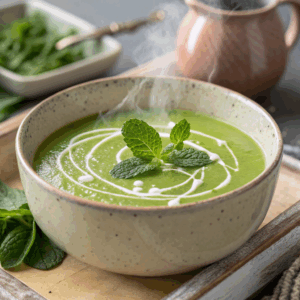
Pea and Mint Soup – Easy & Creamy Spring Recipe
Equipment
- Cutting board and knife
Ingredients
- 4 cups 600g fresh peas (or frozen if fresh aren’t available)
- 1 cup 25g fresh mint leaves, loosely packed, plus extra for garnish
- 1 medium yellow onion chopped
- 2 cloves garlic minced
- 2 tablespoons unsalted butter or olive oil use olive oil for vegan version
- 4 cups vegetable broth or vegetable stock
- 1/2 cup coconut milk or heavy cream
- 1 teaspoon salt or teaspoon sea salt for a more mineral flavor
- Freshly ground black pepper to taste
- 1 tablespoon lemon juice
- Optional garnishes: pea shoots spring onions, creme fraiche, or a drizzle of extra virgin olive oil
Instructions
Step 1: Prepare Your Base
- In a large saucepan over medium heat, melt the unsalted butter or warm the olive oil.
- Add the chopped yellow onion and cook until translucent, about 5 minutes, stirring occasionally.
- Add the minced garlic and continue cooking for another minute until fragrant. Be careful not to let the garlic brown as this can make it bitter.
Step 2: Add Peas and Broth
- Add the fresh peas (or frozen) to the pan and stir to coat them with the onion mixture.
- Pour in the vegetable broth or vegetable stock and bring to a gentle simmer over medium-high heat.
- Once simmering, reduce to low heat and cook for about 5-7 minutes until the peas are tender but still bright green.
Step 3: Add The Mint
- Remove the pan from the heat and add the fresh mint leaves. The residual heat will wilt the mint and release its oils without destroying its bright flavor.
- Allow the mixture to cool slightly for about 5 minutes. This step is important as it preserves the vibrant color and prevents the mint from becoming bitter.
Step 4: Blend to Perfection
- Using an immersion blender or hand blender, carefully puree the soup directly in the pot until smooth. Alternatively, you can transfer batches to a food processor to achieve a silky purée soup.
- If you prefer a thinner soup, add a bit more vegetable broth at this stage.
Step 5: Finish and Season
- Return the soup to low heat and stir in the coconut milk or cream.
- Add teaspoon salt, black pepper, and a squeeze of lemon juice.
- Warm gently without boiling (boiling can dull the bright color and fresh flavors).
- Taste and adjust seasonings as needed. The combination of mint with the sweetness of peas should be balanced and bright.
Step 6: Serve and Garnish
- Ladle the warm soup into soup bowls.
- Garnish with any combination of: a few small fresh mint leaves, a swirl of creme fraiche or sour cream, a drizzle of extra virgin olive oil, pea shoots, or finely chopped spring onions.
- Serve immediately with crusty bread for a complete delicious meal.
Notes
Pro Tips For Perfect Pea and Mint Soup
Choosing Your Peas- Fresh peas straight from the pod make the most exceptional soup, but they’re seasonal and time-consuming to shell
- Frozen peas are an excellent alternative and often more convenient – they’re flash-frozen at peak freshness
- If using frozen peas, don’t thaw them first; add them directly to the pot
- Visit your local farmers’ market or grocery store during spring for the freshest delicate peas
- Use fresh mint leaves only; dried mint won’t provide the same bright flavor
- Add mint off the heat to preserve its volatile oils and prevent bitterness
- Different mint varieties offer subtly different flavors – spearmint is traditional, but chocolate mint or pineapple mint can create interesting variations
- Save a few of the smallest, most tender mint leaves for garnish
- Don’t overcook the peas – they should remain bright green
- For an ultra-silky soup, pass it through a fine-mesh strainer after blending
- If you like some texture, reserve a few tablespoons of cooked peas before blending and add them back afterward
- The hand blender technique: blend in pulses rather than continuously for better control over the final texture

